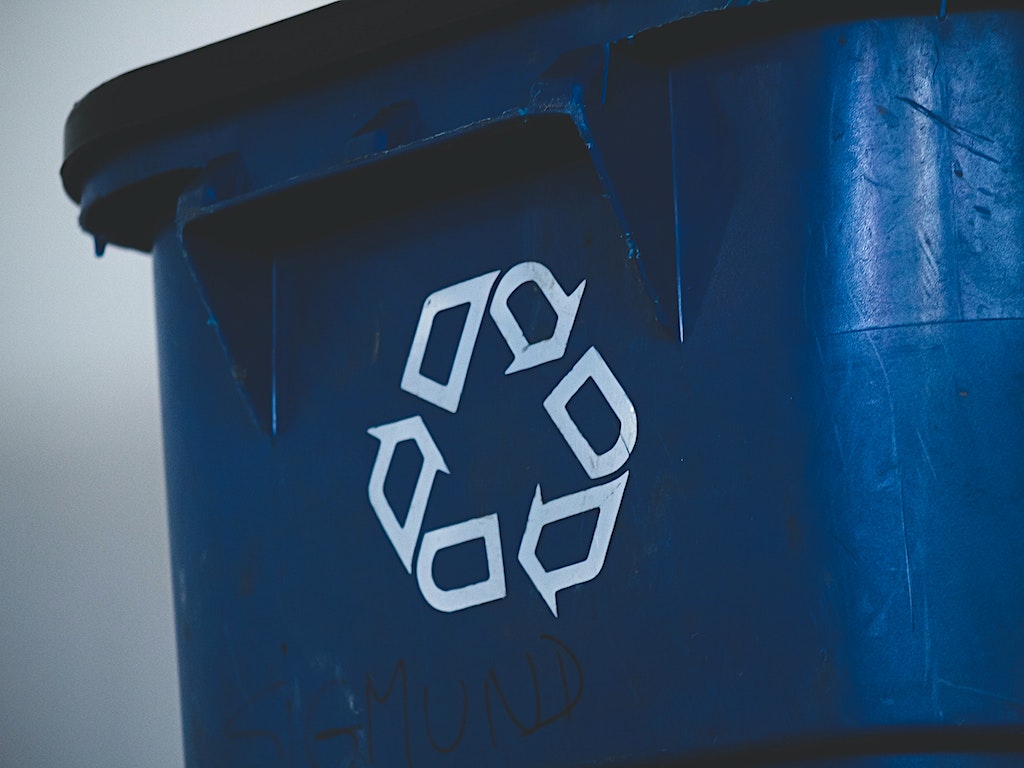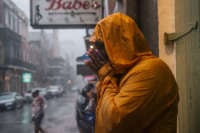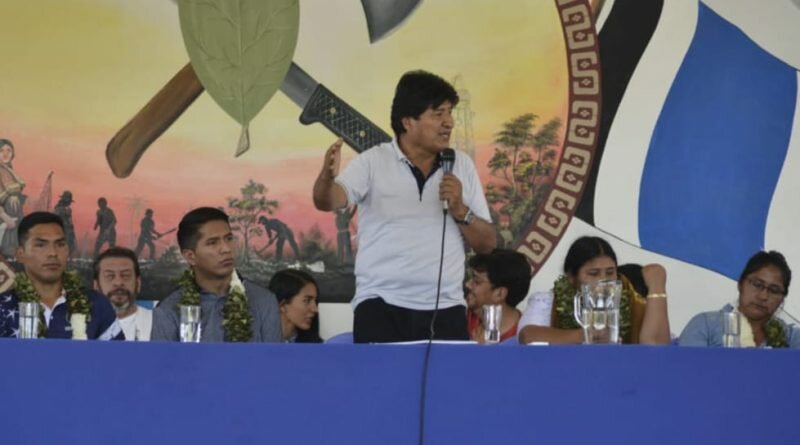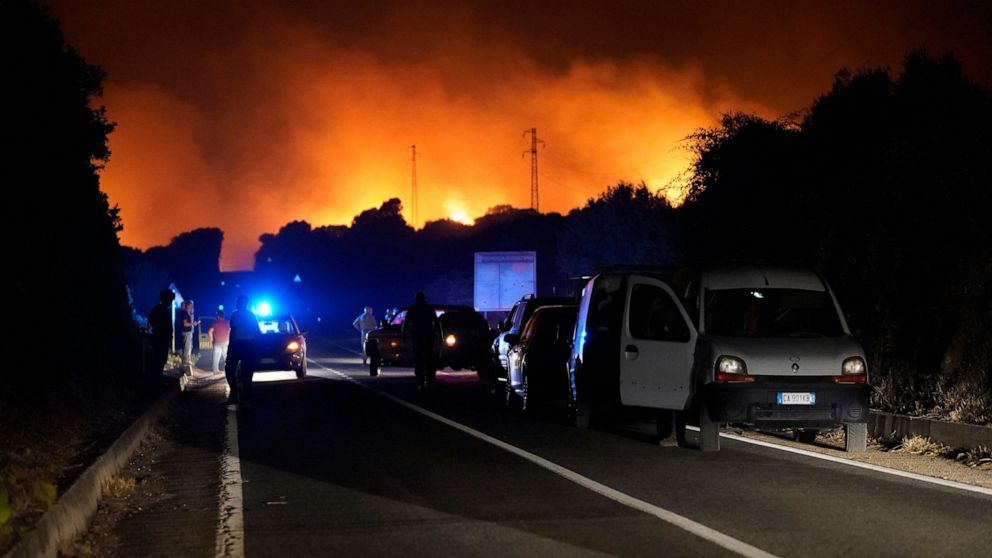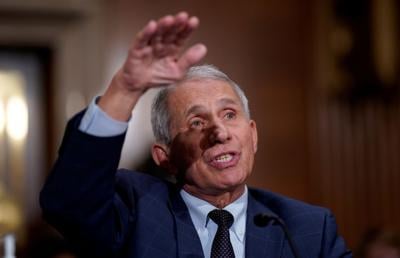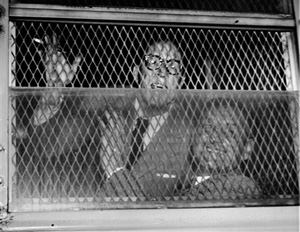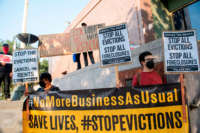In a shocking story out of California, at least one person was stabbed and two journalists attacked while covering an anti-vax, anti-mask demonstration outside Los Angeles City Hall on Saturday, August 14th. That was two Saturdays ago. The protest was attended by members of the Proud Boys and other right-wing groups. KPCC Radio reporter Frank Stoltze was assaulted while doing an interview. He had his glasses ripped off, was repeatedly kicked. He said nothing like that had ever happened to him in his 30 years of reporting.
TINA–DESIREE BERG: It was a wild day. I got there about 45 minutes before the violence actually started, because I had been — I had just released a story that morning, Saturday, where one of our gubernatorial candidates, Sarah Stephens, she had been involved with another press beating in front of the Wi Spa almost three weeks ago. I had filmed that beating. And coincidentally, the folks that did it had posted bodycam footage of themselves inside the vehicle as they were leaving, and they posted it on social media. So, when I saw that, I knew who had been responsible. But one of the persons in the vehicle was Sarah Stephens. She’s running for governor right now. And we were able to identify her not only through her license plate, but also through video surrounding the incident where you see her on the sidewalk. So my intention that morning was to go down, since she was one of the keynote speakers, and maybe try to talk to her about what happened at Wi Spa two weeks before, because I think that’s a newsworthy conversation to have if you’re running for governor.
But we never made it that far. So, initially, on the sidewalk, a group of me and other reporters were standing there. There had been some skateboarders that had been going up and down First Street and Spring Street, and they were preteens, kids. Maybe the oldest was 15, it seemed to me. I didn’t videotape much of them because I generally don’t videotape children. But at one point, one of the Proud Boys — his name is Benjamin Patino — came across the street and started harassing one of the skateboarders and calling them antifa. So, these guys, they have a broad brush with what they state to be antifa. They see antifa where there’s no antifa often, in my experience. So, he started harassing one of these skateboarders, and somebody that is in black bloc came to this kid’s defense and pushed Patino away.
Patino ran back across the street, but then he came back over with Adam Kiefer, who is another Proud Boy, Tony Moon, who is a Capitol insurrectionist, and a group of other folks, and I’m not sure who all of the other ones were. And that’s when you had the incident of one of them came up to me, called me a B-I-T-C-H — I’m not sure if we can say that — and he punched me in the camera. But I kept filming.
Then Tony Moon came over, and he had been hitting another woman with his water bottle, and I tried to intervene a little bit while I was filming, because I could see she had a bloody head. She had been hit in the head. And so, then he started screaming, “Unmask them all!” He ripped my mask off and manhandled me or shoved me a little bit. But then I kept filming.
And right after that, you’ll notice in the background of the video there is a counterprotester, who is pro-vaccine, who was — looks like he’s getting beaten by fists, but it turns out that that individual had a shank of some sort in his hand and was actually trying to stab him. So, that’s the second stabbing. The first stabbing had happened earlier. I didn’t catch it on video, but I did see the gentleman coming by from behind, walking towards the police officers, and you can see there’s blood on his shirt. And then he’s collapsed in the street, and they’re giving him aid. So, as far as I know, there’s definitely two stabbings. There might be more that I didn’t quite catch. But it was a very violent scene.
And it’s interesting to me, because some of these characters, including Tony Moon — he was also, incidentally, at that same Wi Spa event where this other press member was hit on the back of the head with a lead pipe. Tony Moon was there that day also with a water bottle, and he struck a counterprotester with that. So, I think it’s interesting, Amy, that this is a group that has been traveling around Southern California, they’ve also been up in Sacramento, they have also been up in Portland, and they instigate violence wherever they go. And again, these are — they’re right-wingers. They are definitely part of the group that supported Trump, but I don’t think this is solely about Trump anymore, or necessarily anti-vaccine. I think that they are just latching on from one movement to the next, and they’re kind of coalesced around this idea of freedom. And you’ll notice that they all have these gaiters on that are covering their faces. They’re not trying to prevent the spread of COVID; they’re trying to stop themselves from being identified.
AMY GOODMAN: Tell us more about the direct attack on you and how you know who Tony Moon is and that he was at the insurrection, January 6, at the Capitol.
TINA–DESIREE BERG: Yeah, so, I know who Tony Moon is because he had been at that Wi Spa event two weeks earlier. After I saw him hit the woman with the water bottle, I got online and started to research who he was, and I saw that he had been at the Capitol January 6th, because he had posted video of himself on his social media showing that he had been. And there was also a clip in the Parler archive, that’s on ProPublica, where you see him in that video. So he was definitely there.
And I think it also bears mentioning that he identifies himself as “Roof Korean,” and that is a very racist trope that goes back to the beating of Rodney King. So, he’s definitely identifying himself as a group that’s already radical right, racist, doing violence. So, yeah, he was there at Wi Spa. We looked into who he was. And then, when I saw him coming up to me, I said, “Oh, there’s Tony Moon. That’s the Roof Korean guy that was at Wi Spa a couple weeks ago.” But I will say this: He seemed much more violent and radicalized Saturday morning.
I think also maybe there’s a double meaning to “unmask them,” because we were all wearing masks for protection, so I had my surgical mask on. I think his idea is that not only are we unmasking you because we’re anti-vaxxers and we’re anti-maskers and we see this as an infringement to freedom, but also they’re very vested in this idea of doxxing and exposing anybody that is against, you know, their beliefs. Now, randomly, of course, I use my real name, so there’s not much to dox there, but I do think that’s why he was screaming, “Unmask them all!” It wasn’t solely because of the mask to prevent COVID transmission.
AMY GOODMAN: I want to throw to a clip of he attack on you, that you yourself filmed.
PROUD BOY: Hey, bitch!
TINA–DESIREE BERG: Hey! Yo! Stop it!
TONY MOON: Unmask them! Unmask them!
TINA–DESIREE BERG: [bleep] you!
TONY MOON: Unmask them! Unmask them!
TINA–DESIREE BERG: Yeah, so, the first guy that came up and punched me was not Tony Moon. It was another gentleman. He came right up to the camera. He called me the B-word and hit me, backed away back where the guys were. So he absolutely targeted me for some reason. I’m not sure why that is.
And then, you know, maybe 20, 30 seconds later, Tony Moon was right there. So, when he came up to me, you could tell his intention was to pull down — and he did pull it down — my mask. And I had put up my goggles at that point, as well, because somebody had been using bear mace. And, in fact, I believe it was the anti-vaxxer that was stabbed that had used bear mace, because I do have video of him earlier using bear mace and spraying people. This is a tactic that the Proud Boys have deployed for many months now. So we’ve seen it at various different protests, where they pull out bear mace and they mace people. So, he did successfully pull my mask down. He was, like I said, hitting that other woman — you’ll see she has a bloody head — and just kind of escalated from there and started screaming, “Unmask them all!”
And I also think it’s interesting that if you look at the video, you see that they all have orange armbands on and that their water bottles are all orange. So, obviously, orange is a significant color for them. I don’t know if they’re coordinating with it, but you will see they have orange armbands. And it sort of is reminiscent of January 6 at the Capitol, because, that day, the Proud Boys had been marking themselves with orange gaffer tape or orange beanies on their heads. And they had, at that point — Enrique Tarrio had told everybody to show up dressed not as they normally would in their Proud Boy attire, but into, you know, sort of antifa in disguise, and they had been marking themselves, ergo, with the orange color, whether it was the tape, the gaffer tape, or the beanies. I don’t know that there’s a crossover here with the group that was with Tony Moon, but I do think it’s interesting that they all had orange armbands on.
AMY GOODMAN: How did you personally feel when this was happening to you? I mean, this was a anti-mask, anti-vax rally. They’re pulling down your mask.
TINA–DESIREE BERG: I was actually very concerned about — in the moment, because you know that these folks aren’t vaccinated. I am absolutely fully vaccinated, but there’s still a chance of transmission. And that’s actually — I’ve been hit before. You know, when you’re in the field covering things, it’s something that sometimes happens, so this is not the first time I’ve been hit doing my job. But I was really concerned that they were willing to get so close to me and get into my face and pulled down my mask. And they — you know, higher chance, obviously, that they’re infected with COVID since they’re not vaccinated. So, that’s actually more scary to me than being punched. I do not want to get COVID, right? So, it was a violation of personal space. But I was just very focused on getting the video and staying focused on what I was filming in that moment.
AMY GOODMAN: Tina-Desiree Berg, where were the police? You were right in front of LAPD headquarters?
TINA–DESIREE BERG: Yeah, that’s right. That’s right. So, I think that’s a significant part of the story. So, City Hall is stationed exactly across the street from LAPD headquarters. And where this bully happened is in the sidewalk and the street area right in front of the headquarters. The police had been there all morning. When I got there, there was probably five or six cruisers lined up with officers in them. So they were absolutely present. And I don’t know what the delay was, as far as, you know, not responding to what was going on, but they did not initially respond.
AMY GOODMAN: And then, track the people, some of the people that you saw there at this protest, along the coast, from California to Oregon to Washington.
TINA–DESIREE BERG: Right. So, the main guide that you see coming out — OK, so there’s Patino that came across the street, Benjamin Patino, and messed with the skateboarder kid and then went back.
Then you see another one appear. His name is Adam Kiefer. He is actually part of a more violent group that I’ve seen. And, in fact, related to this, I was covering another anti-vax protest in West Hollywood a couple of weeks ago, and Adam Kiefer came across the street towards me and two other journalists and started threatening us. I have some video of that, and in it, you’ll see him say, “Why are you throwing rocks at me?” — and which nobody was doing. Obviously, none of us were throwing rocks. And I respond to Adam, “I’m not throwing rocks. Nobody here is throwing rocks. We’re just journalists.” And then they ended up getting more aggressive. We ended up running into the Trader Joe’s and seeking refuge in there. They actually had to shut down the store for a few minutes, until they called the sheriff’s department to show up.
But so, I’ve seen him there. I have seen him in Huntington Beach as part of a group that’s been at the Huntington Beach rallies. Those were happening every week during the run-up to the general election. They were pro-Trump. He’s been in Beverly Hills assaulting people. They also had weekly rallies there at the Beverly Garland Park, which is right off of Wilshire Boulevard. So, I also have filmed him in Sacramento being violent, beating up people. So this is somebody that’s definitely traveled around.
So, it’s interesting to me, though, that at this point, Amy, that these guys are very dedicated to what they’re doing. And I don’t know that if you had ask them five or six years ago if they were anti-vaccine, that they would respond with an affirmative. I think this is just one more cause that they’ve picked up because they do see it as a violation of their freedoms.
AMY GOODMAN: Tina, how does this whole protest movement dovetail with the recall Governor Newsom movement?
TINA–DESIREE BERG: Yeah, that’s an excellent question. So, because this was — they called this a “freedom rally,” and that was part of the equation, was that we’re going to also have candidates that are running for governor here that are against Newsom. So, recall Newsom is definitely gaining speed here in California. You know, Sarah Stephens, which is the candidate that I mentioned earlier, she was involved with another Proud Boy, Aaron Simmons, at this Wi Spa assault. She drove the getaway car. So she’s definitely tied with these guys.
I was down in San Diego a couple of weeks ago trying to film a — Mike Pompeo was here, and he was doing a rally for Larry Elder, who is actually tracking number one right now to win if Newsom is recalled. It was an event that was hosted by a Christian Zionist group. Jewish Voice for Peace and the Palestinian Youth Movement joined together to do a counterprotest and rally. So I went down to film that. I covered the speeches and part of the march. But when we got to where Mike Pompeo was speaking, where Larry Elder was speaking, there was a group that had set up some sort of a phony barricade in front of the street, so we couldn’t get further. And as you approached them, they were — in much the same way you saw them menacing on Saturday, they were menacing us and egging people on — “Come here” — you know, very angry way.
I researched some of those guys. There was one named Mike Forzano, who is also a Proud Boy. He is also a member of the American Guard, which is a designated hate group from the Southern Poverty Law Center. He was one of them. He bear-maced me. He hit me, hit my phone out of my hand. And I’m sure that there were others there that I didn’t see that traveled down from Orange County, what have you.
But this is definitely a widespread thing here in California. And I think it’s probably shocking for a lot of folks outside of the state, because they see California as being a, you know, liberal, progressive state. But we do have an element of very hard-right folks here. And they do — they have become much more vocal under the Trump administration.
AMY GOODMAN: So, can you also tell us about what happened? I believe it was right at the same time as the insurrectionists were storming the Capitol that there were local protests around the country. And the attack on the Black trans woman in L.A., how this fits into the story? Her name was Berlinda. She was 25 years old.
TINA–DESIREE BERG: That’s right.
AMY GOODMAN: She said a large group of pro-Trump supporters attacked her.
TINA–DESIREE BERG: That is absolutely correct. So, she had — and I filmed this. I was there for that protest. My co-worker, associate Jon Farina was in the Capitol shooting that day. So, he was actually in the tunnel when the police officer had his head squished, filming that. And I remember, at the end of the day, where I was, I called Jordan, and I said, “I just filmed a hate crime.” And Jordan was like, “You obviously haven’t tuned in to what’s happening in D.C. today.” And I’m like, “No, is it worse?” He said, “Yes” — as an aside.
But Berlinda had just been walking down the street, because she lives in the area. And they came up to her. They held her back. They sprayed her with bear mace. And the worst part of it is a group of them grabbed her weave off of her head, and one of them was holding up the weave and screaming, “This is the first scalping of the new Civil War!” It was one of the most appalling things I’ve ever witnessed. Just appalling. And she was one of two individuals that I saw bear-maced that day. They did bear-mace a second Black individual that was walking through the park.
But here’s where this ties into the LAPD and where they bring their clear bias to the skirmish line. So, she went up to Stabile, who is one of the commanding officers for that division, and wanted to, you know, say, “Look, I was just assaulted. This is what happened.” And Stabile says to her — and I have all of this on video — Stabile says to her, “Well, you can file a citizen’s arrest.”
So, at that point, I interrupted, because I thought that was pretty appalling. I said, “Stabile, that’s what you do if there’s no probable cause. There’s clear probable cause here. We have the whole thing on video. How is this not a hate crime?”
And do you know, to this day, the LAPD has not investigated this particular thing or, at least as far as I know, brought charges in regards to this?
Now, if you go to Stabile’s personal social media, you will see very clearly that he is pro-Trump, that he talks a lot about antifa and how antifa is bad. He’s definitely, you know, making posts in regards to being anti-mask. And he’s not the only one. There’s another one in this division who’s named Sergeant Helper, and he also has a private — or, separate Instagram and Twitter where he posts some of the same similar sentiments.
So I think there’s definitely a problem that’s being crossed over here. When you have police officers that are in command and they want to bring their personal bias to the skirmish line, they’re going to, you know, let these guys get away with a certain level of violence before they step in. And we’ve seen it time and time again. And I can say without equivocation, if the reverse was happening, if this was BLM activists, if this was antifa or black bloc, they would be pulling their weapons and making arrests and beating people. That’s just not a controversial statement. So I think it is really a problem inside the LAPD at this point.
AMY GOODMAN: And finally, if you could elaborate on what happened in July, the Korean spa called Wi Spa becoming a center of attacks? What’s its significance? And what happened?
TINA–DESIREE BERG: So, this is a very significant part of the story, because it’s, again, part of the same group of individuals, right? So, there had been a customer that had come into Wi Spa, and she was — you see a video that circulated. I think Tucker Carlson at one point picked it up. But she comes out, and she claims that there’s a pedophile, a trans individual, in the dressing room, and that, you know, she’s worried about children, this kind of a thing. So they staged a counterprotest and protest in front of Wi Spa.
Now, I did talk to the security at Wi Spa. They do have transgender clients that attend Wi Spa. There was no transgender clients present that day when this video was shot, so there’s a general feeling — and this is also coming from the LAPD — that that’s actually not an authentic video. I have not been able to verify that. That’s just what I’m being told by security and what the conclusions have been thus far from the investigation.
But this — you know, we had a group that have now combined with these other guys, and they’re very religious, right? So, they were — I have video of one gal. She’s screaming, “You’re animals! You’re going to burn in hell!” There was another gentleman that had a weapon sort of fashioned. It just — you have to see the audio or the video of this. It looks like a giant rosary, where instead of the beads being very small, they’re very large. They’re like about an inch, inch and a half, two inches in diameter. And he’s hitting people with this thing and screaming, “You’re an abomination! You’re an abomination! You’re animals!” You know, so very violent and religiously motivated bigotry. And, of course, now you have the second layer of these Proud Boys and these other folks, right-wingers, coming in and joining the fray and banding together with these guys.
In fact, at the second protest, we saw Based Spartan was there with them. Based Spartan, as you know, is somebody that’s been a subject even of a Vice article. He was up in Portland wearing kind of a Trojan outfit. He lives down here in Southern California. I’ve seen him at many of these protests, as well, hitting people.
So, yeah. So, the Wi Spa thing is significant, and Tony Moon was there, as well. You know, he was, again, hitting — he hit a woman there with a water bottle, as well. So, the violence — these two violent situations, I think, are conjoined, and also because of the Sarah Stephens element, where she was part of the lead pipe attack against Rocky Romano, who is the press member that was hit on the back of the head. She was driving the getaway car. We’ve confirmed that.
So, it’s just wild to me, Amy, that this is what 2021 is bringing us. If you had told me six months ago, even, you know, three months ago, that this would be the level of escalation of violence we would be seeing, I probably would have thought, “Mm, maybe not.” But I feel now very strongly that at some point somebody is probably going to get shot, because these are turning into full-blown sort of prison-level street brawls in the street.
AMY GOODMAN: Let me, finally, ask you: Do you think that women reporters are being particularly targeted, like yourself?
TINA–DESIREE BERG: Absolutely, I think that’s definitely the case. You know, I think it’s either smaller men or definitely women. And, in fact, I was talking with Adam Rose from the L.A. Press Club about this, because he’s noticed there’s an escalation of violence against female reporters across the board.
So, I do think that’s true, mainly because they — I was hit twice in that period of two minutes, and the male journalists were not, although they did go up and attack Frank later on in the day while he was doing an interview. In that first initial brawl out in the front of LAPD headquarters, they were not necessarily going after the male reporters at the same level. They were, however, punching all of the counterprotesters, male or female.
AMY GOODMAN: Well, Tina-Desiree Berg, I want to thank you for being with us. Final question: Does this deter you from going out and covering what’s happening, especially among the Proud Boys?
TINA–DESIREE BERG: No, it doesn’t. And I’ll tell you why, Amy. People need to see what’s going on. And if I let them control what I do, then they kind of win the conversation. That’s the point of what they’re doing, right? To intimidate, to stop. They don’t want the press. They don’t want people filming them. They don’t want to be exposed for their violent actions. And so, the intention of what they’re doing is to try to silence me and other journalists like me from covering what they’re doing. And I absolutely am not deterred from doing it.
I will, however, be much more aware, take more, probably, safety precautions. You know, I go out now with a full set of safety precautions now that I never did before. I never used to wear any — a flak vest. I never used to wear a helmet. This just didn’t seem like necessary. I’m not in a war zone, right? But maybe that’s the case. Maybe this is where the United States is heading right now, because I feel that these groups are becoming more radicalized as time goes by.
And I think the next thing that we’re going to see, at least here in California, is sort of “stop the steal,” California edition, right? Because if Newsom does prevail and he does not get recalled, I think we’re going to see a whole host of these guys coming out and saying that it’s a rigged election, that the election results are false, and it won’t matter whether there’s any underlying evidence to prove that.
AMY GOODMAN: And, Tina, just to be clear, since you have so much of this video, and have shown it, have tweeted it out — and we’ve been showing it throughout this interview — was anyone arrested for attacking you?
TINA–DESIREE BERG: No.
AMY GOODMAN: Was anyone arrested for bloodying the other woman?
TINA–DESIREE BERG: No.
AMY GOODMAN: Was anyone arrested for the knifing?
TINA–DESIREE BERG: No. That’s the thing. Nobody has been arrested. So, I know that the LAPD is now looking for suspects in both stabbings, apparently, which — this is surprising to me. They’re saying yesterday, during the police commissioner’s hearing, that they weren’t aware of the second stabbing, but that they are now, and they’re going to look for the attackers.
But here’s the thing that’s troublesome about this. The attackers were there present that day, and if they had been arrested, detained or dealt with, we’d know who they are. But now it’s going to be very difficult to chase them down, because they were all covered up. You can’t really — it’s hard to decide who these folks are, because they have the gaiters up over their head. They have hats on, goggles, what have you. It’s going to be very hard to identify them. So, waiting to follow up on these acts of violence is very detrimental to the investigation.
That does it for the show. Very Happy Birthday to Julie Crosby! I’m Amy Goodman.






